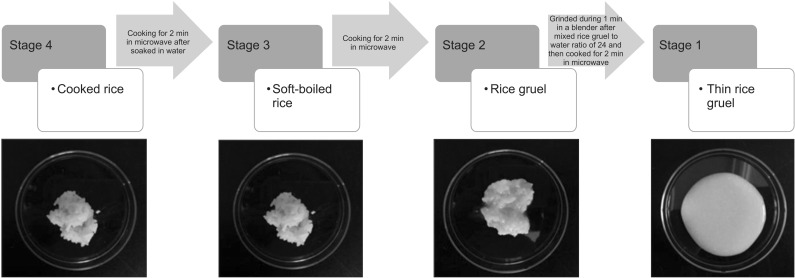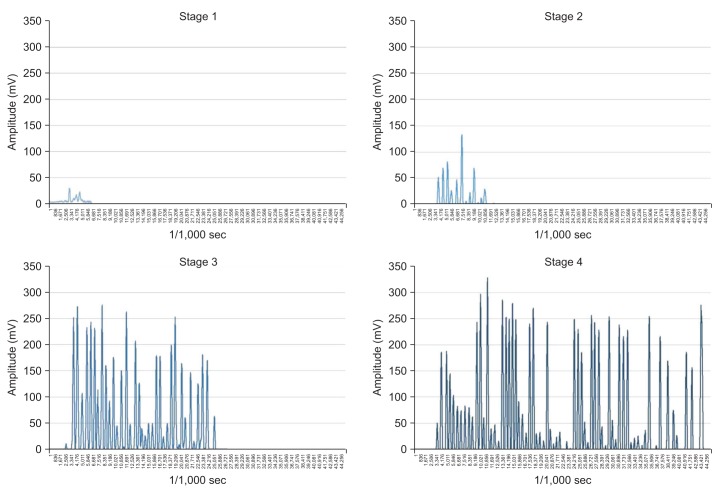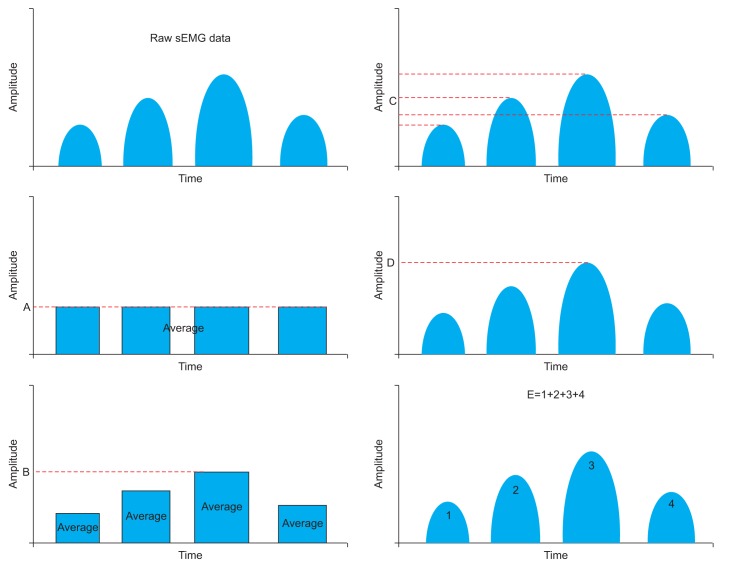Ann Rehabil Med.
2016 Jun;40(3):447-456. 10.5535/arm.2016.40.3.447.
EMG Activity of Masseter Muscles in the Elderly According to Rheological Properties of Solid Food
- Affiliations
-
- 1Department of Physical Medicine and Rehabilitation, Chung-Ang University College of Medicine, Seoul, Korea. donkim21@cau.ac.kr
- 2Department of Food Science & Technology, Chung-Ang University, Seoul, Korea.
- KMID: 2327606
- DOI: http://doi.org/10.5535/arm.2016.40.3.447
Abstract
OBJECTIVE
To assess the impact of aging on masticatory muscle function according to changes in hardness of solid food.
METHODS
Each of fifteen healthy elderly and young people were selected. Subjects were asked to consume cooked rice, which was processed using the guidelines of the Universal Design Foods concept for elderly people (Japan Care Food Conference 2012). The properties of each cooked rice were categorized as grade 1, 2, 3 and 4 (5×10³, 2×10â´, 5×10â´, and 5×10âµ N/m²) respectively. Surface electromyography (sEMG) was used to measure masseter activity from food ingestion to swallowing of test foods. The raw data was normalized by the ratio of sEMG activity to maximal voluntary contraction and compared among subjects. The data was divided according to each sequence of mastication and then calculated within the parameters of EMG activities.
RESULTS
Intraoral tongue pressure was significantly higher in the young than in the elderly (p<0.05). Maximal value of average amplitude of the sequence in whole mastication showed significant positive correlation with hardness of food in both young and elderly groups (p<0.05). In a comparisons between groups, the maximal value of average amplitude of the sequence in whole mastication and peak amplitude in whole mastication showed that mastication in the elderly requires a higher percentage of maximal muscle activity than in the young, even with soft foods (p<0.05).
CONCLUSION
sEMG data of the masseter can provide valuable information to aid in the selection of foods according to hardness for the elderly. The results also support the necessity of specialized food preparation or products for the elderly.
MeSH Terms
Figure
Reference
-
1. Choi SJ. The family and ageing in Korea: a new concern and challenge. Ageing Soc. 1996; 16:1–25.
Article2. Locker D, Slade G. the oral health impact profile. J Can Dent Assoc. 1993; 59:830–833. 837–838. 844PMID: 8221283.3. Miura H, Miura K, Mizugai H, Arai Y, Umenai T, Isogai E. Chewing ability and quality of life among the elderly residing in a rural community in Japan. J Oral Rehabil. 2000; 27:731–734. PMID: 10931271.
Article4. Ikebe K, Hazeyama T, Morii K, Matsuda K, Maeda Y, Nokubi T. Impact of masticatory performance on oral health-related quality of life for elderly Japanese. Int J Prosthodont. 2007; 20:478–485. PMID: 17944335.5. Martin BJ, Corlew MM, Wood H, Olson D, Golopol LA, Wingo M, et al. The association of swallowing dysfunction and aspiration pneumonia. Dysphagia. 1994; 9:1–6. PMID: 8131418.
Article6. Mioche L, Bourdiol P, Peyron MA. Influence of age on mastication: effects on eating behaviour. Nutr Res Rev. 2004; 17:43–54. PMID: 19079914.
Article7. Peyron MA, Mishellany A, Woda A. Particle size distribution of food boluses after mastication of six natural foods. J Dent Res. 2004; 83:578–582. PMID: 15218050.
Article8. Mowlana F, Heath MR, Van der Bilt A, Van der Glas HW. Assessment of chewing efficiency: a comparison of particle size distribution determined using optical scanning and sieving of almonds. J Oral Rehabil. 1994; 21:545–551. PMID: 7996338.
Article9. Lucas PW, Luke DA, Voon FC, Chew CL, Ow R. Food breakdown patterns produced by human subjects possessing artificial and natural teeth. J Oral Rehabil. 1986; 13:205–214. PMID: 3458889.
Article10. Ishikawa Y, Watanabe I, Hayakawa I, Minakuchi S, Uchida T. Evaluations of masticatory performance of complete denture wearers using color-changeable chewing gum and other evaluating methods. J Med Dent Sci. 2007; 54:65–70. PMID: 19845137.11. Tanimoto Y, Watanabe M, Kono R, Hirota C, Takasaki K, Kono K. Utility of color-changeable chewing gum to evaluate masticatory ability in communitydwelling elderly persons. Nihon Koshu Eisei Zasshi. 2009; 56:383–390. PMID: 19663266.12. Ferrario VF, Sforza C, Zanotti G, Tartaglia GM. Maximal bite forces in healthy young adults as predicted by surface electromyography. J Dent. 2004; 32:451–457. PMID: 15240063.
Article13. Ferrario VF, Sforza C, Colombo A, Ciusa V. An electromyographic investigation of masticatory muscles symmetry in normo-occlusion subjects. J Oral Rehabil. 2000; 27:33–40. PMID: 10632841.
Article14. Kohyama K, Mioche L. Chewing behavior observed at different stages of mastication for six foods, studied by electromyography and jaw kinematics in young and elderly subjects. J Texture Stud. 2004; 35:395–414.
Article15. Kohyama K, Mioche L, Martin JF. Chewing patterns of various texture foods studied by electromyography in young and elderly populations. J Texture Stud. 2002; 33:269–283.
Article16. Peyron MA, Blanc O, Lund JP, Woda A. Influence of age on adaptability of human mastication. J Neurophysiol. 2004; 92:773–779. PMID: 15277595.
Article17. Lehman GJ, McGill SM. The importance of normalization in the interpretation of surface electromyography: a proof of principle. J Manipulative Physiol Ther. 1999; 22:444–446. PMID: 10519560.
Article18. Yang JF, Winter DA. Electromyographic amplitude normalization methods: improving their sensitivity as diagnostic tools in gait analysis. Arch Phys Med Rehabil. 1984; 65:517–521. PMID: 6477083.19. Ekstrom RA, Soderberg GL, Donatelli RA. Normalization procedures using maximum voluntary isometric contractions for the serratus anterior and trapezius muscles during surface EMG analysis. J Electromyogr Kinesiol. 2005; 15:418–428. PMID: 15811612.
Article20. Kohyama K, Yamaguchi M, Kobori C, Nakayama Y, Hayakawa F, Sasaki T. Mastication effort estimated by electromyography for cooked rice of differing water content. Biosci Biotechnol Biochem. 2005; 69:1669–1676. PMID: 16195583.
Article21. Feldman RS, Kapur KK, Alman JE, Chauncey HH. Aging and mastication: changes in performance and in the swallowing threshold with natural dentition. J Am Geriatr Soc. 1980; 28:97–103. PMID: 7354209.
Article22. Ono T, Iwata H, Hori K, Tamine K, Kondoh J, Hamanaka S, et al. Evaluation of tongue-, jaw-, and swallowing-related muscle coordination during voluntarily triggered swallowing. Int J Prosthodont. 2009; 22:493–498. PMID: 20095201.
- Full Text Links
- Actions
-
Cited
- CITED
-
- Close
- Share
- Similar articles
-
- A STUDY ON THE EFFECTS TEXTURE OF FOOD ON CHEWING MOVEMENTS AND EMG OF MASTICATORY MUSCLE
- Comparative Electromyographic Analysis Of Masticatory Muscles Between Bilateral And Unilateral Masticators
- The effects of facial denervation on facial muscles and bones in growing rabbits
- A comparative study on the muscle activity of the anterior openbite and normal occlusion
- An electromyographic study of the muscle activity in Angle's Class II div. 1 malocclusion and normal occlusion




